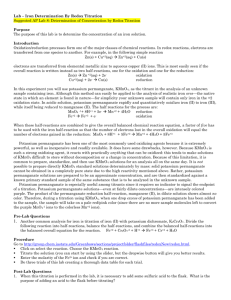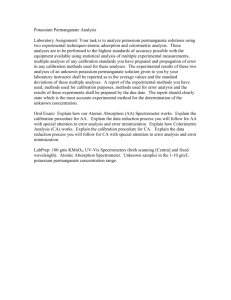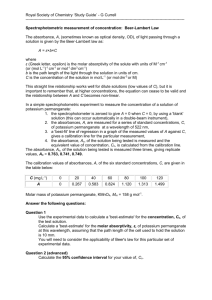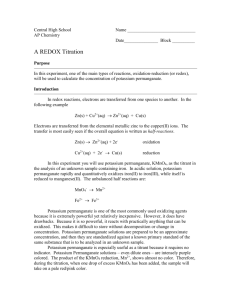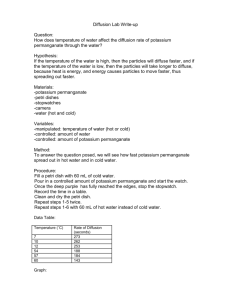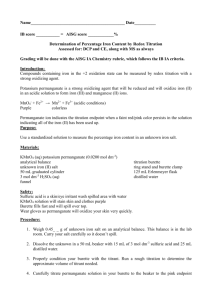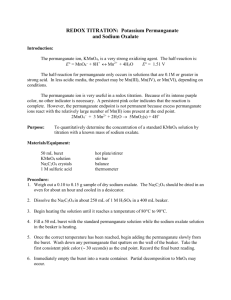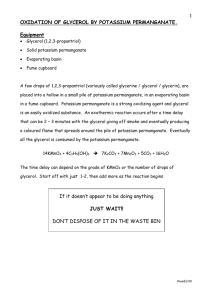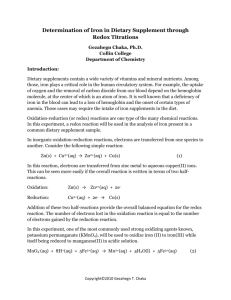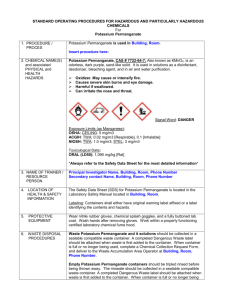Iron Redox Titration Lab: KMnO4 Analysis
advertisement
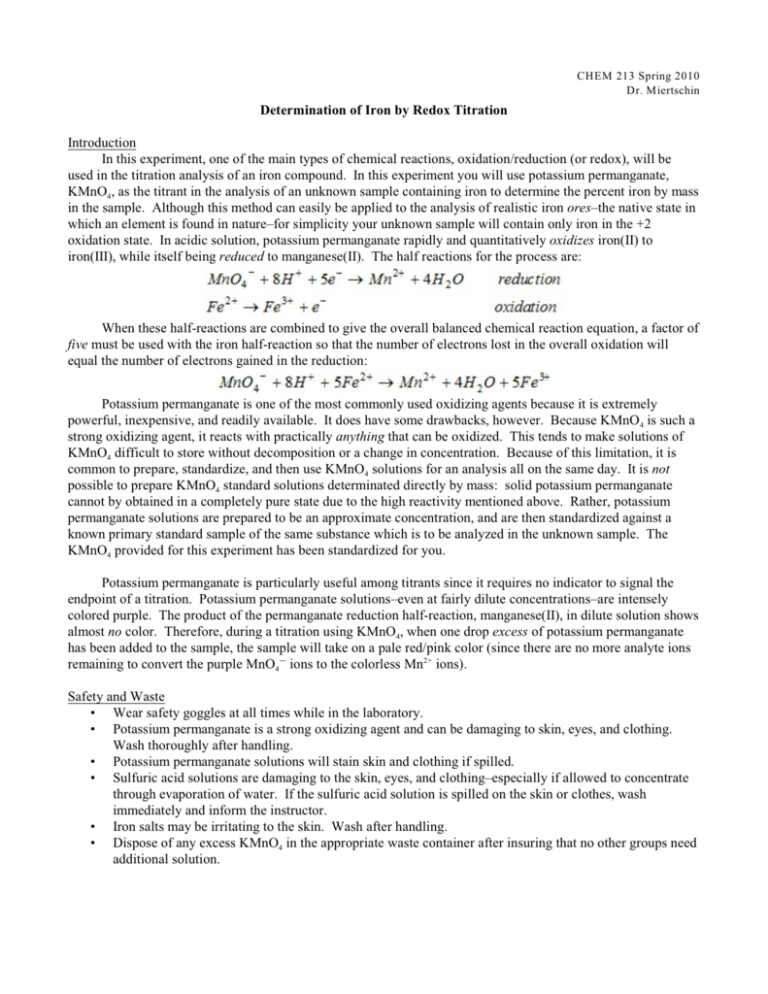
CHEM 213 Spring 2010 Dr. Miertschin Determination of Iron by Redox Titration Introduction In this experiment, one of the main types of chemical reactions, oxidation/reduction (or redox), will be used in the titration analysis of an iron compound. In this experiment you will use potassium permanganate, KMnO4 , as the titrant in the analysis of an unknown sample containing iron to determine the percent iron by mass in the sample. Although this method can easily be applied to the analysis of realistic iron ores–the native state in which an element is found in nature–for simplicity your unknown sample will contain only iron in the +2 oxidation state. In acidic solution, potassium permanganate rapidly and quantitatively oxidizes iron(II) to iron(III), while itself being reduced to manganese(II). The half reactions for the process are: When these half-reactions are combined to give the overall balanced chemical reaction equation, a factor of five must be used with the iron half-reaction so that the number of electrons lost in the overall oxidation will equal the number of electrons gained in the reduction: Potassium permanganate is one of the most commonly used oxidizing agents because it is extremely powerful, inexpensive, and readily available. It does have some drawbacks, however. Because KMnO4 is such a strong oxidizing agent, it reacts with practically anything that can be oxidized. This tends to make solutions of KMnO4 difficult to store without decomposition or a change in concentration. Because of this limitation, it is common to prepare, standardize, and then use KMnO4 solutions for an analysis all on the same day. It is not possible to prepare KMnO4 standard solutions determinated directly by mass: solid potassium permanganate cannot by obtained in a completely pure state due to the high reactivity mentioned above. Rather, potassium permanganate solutions are prepared to be an approximate concentration, and are then standardized against a known primary standard sample of the same substance which is to be analyzed in the unknown sample. The KMnO4 provided for this experiment has been standardized for you. Potassium permanganate is particularly useful among titrants since it requires no indicator to signal the endpoint of a titration. Potassium permanganate solutions–even at fairly dilute concentrations–are intensely colored purple. The product of the permanganate reduction half-reaction, manganese(II), in dilute solution shows almost no color. Therefore, during a titration using KMnO4, when one drop excess of potassium permanganate has been added to the sample, the sample will take on a pale red/pink color (since there are no more analyte ions remaining to convert the purple MnO4G ions to the colorless Mn2+ ions). Safety and Waste • Wear safety goggles at all times while in the laboratory. • Potassium permanganate is a strong oxidizing agent and can be damaging to skin, eyes, and clothing. Wash thoroughly after handling. • Potassium permanganate solutions will stain skin and clothing if spilled. • Sulfuric acid solutions are damaging to the skin, eyes, and clothing–especially if allowed to concentrate through evaporation of water. If the sulfuric acid solution is spilled on the skin or clothes, wash immediately and inform the instructor. • Iron salts may be irritating to the skin. Wash after handling. • Dispose of any excess KMnO4 in the appropriate waste container after insuring that no other groups need additional solution. CHEM 213 Spring 2010 Dr. Miertschin Materials potassium permanganate buret and clamp iron unknown sample appropriate glassware 3 M sulfuric acid magnetic stirrer Procedure A. Preparation of the Iron Unknown samples Record your unknown sample number. Clean three 100- or 150-mL beakers with soap and water. Rinse with several small portions of distilled water. The iron(II) compounds to be used for the titration with potassium permanganate solution contain the salt ferrous ammonium sulfate hexahydrate (Mohr’s salt), FeSO 4@(NH 4) 2SO4@6H2O, which is abbreviated as FAS. Directly into each beaker, carefully weigh ~0.5 g of your unknown to the nearest milligram (0.001 g). Add 15 mL of distilled water to each sample and stir to dissolve the solid. Add 8 mL of 3 M sulfuric acid, H2SO4, to each sample (Caution!). Sulfuric acid is added to the samples to provide the hydrogen ions, H+ , required for the reduction of the permanganate ion. B. Titration of the Iron Unknown Potassium Permanganate Solution Obtain approximately 55 mL of the standardized potassium permanganate, KMnO4, solution. This amount should be sufficient for all three titrations. Record the exact concentration of the KMnO4 solution. Obtain a buret with white numbering. Prepare the buret for titrating by cleaning, rinsing, and filling with potassium permanganate solution. Since potassium permanganate solutions are so intensely colored, it is generally impossible to see the curved meniscus that the solution surface forms in the buret. In this case, it is acceptable to make your liquid level readings at the point where the top surface of the permanganate solution comes in contact with the wall of the buret. Record the initial volume reading to the nearest 0.01 mL. Titrate each sample to the endpoint. The endpoint is the first appearance of a permanent, pale pink color. Record the final buret reading (to the nearest 0.01 mL) Results The moles and, hence, mass of iron in each sample can be determined from the volume required to titrate each unknown sample and the average molarity of the KMnO4 solution. The mass percent of iron in each sample can be calculated from the mass of iron present in each unknown sample and each sample’s mass. Report the average mass percent of iron in your unknown sample. Once you have calculated the % Fe in your sample, you will be provided with the actual % Fe value for comparison and calculation of the % error. Report Your notebook need only include the pre-lab sections, an experimental section, and results section for this part. You may omit the error and conclusion sections. Include the following: • Calculate the % Fe (by mass) of your unknown. (Results) • Calculate the % error of your unknown. (Results)
